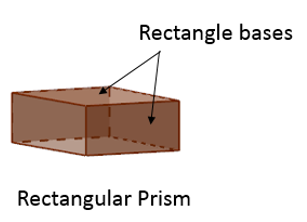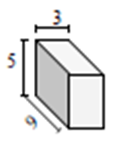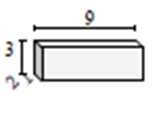
- Surface Areas
- Home
- Nets of solids
- Surface area of a cube or a rectangular prism
- Surface area of a rectangular prism made of unit cubes
- Distinguishing between surface area and volume
- Using a net to find the surface area of a rectangular prism
- Word problem involving the surface area of a rectangular prism
- Surface area of a triangular prism
- Using a net to find the surface area of a triangular prism
Surface area of a cube or a rectangular prism
In this lesson, we will learn how to calculate the surface area of a rectangular prism and solve problems on surface area of rectangular prisms.
A prism is a solid that has two parallel faces which are congruent polygons at both ends. These faces form the bases of the prism. A prism is named after the shape of its base. The other faces are in the shape of rectangles. They are called lateral faces.
The following diagram shows a rectangular prism.

A right prism is a prism that has its bases perpendicular to its lateral surfaces.
The surface area of a prism is the total area of all its external faces.
To calculate the surface area of a rectangular prism
We calculate the area of each of the six faces of the prism.
We then add up all the areas to get the total surface area.
Formula to find the surface area of a prism
Surface area of prism = 2 × area of base + perimeter of base × height of prism
Formula to find the surface area of a rectangular prism
Surface area of a rectangular prism = 2 (l × w + w × h + l × h)
Where,
l – length of the prism
w – width of the prism and
h – height of the prism
Find the surface area of the given rectangular prism in square cm.

Solution
Step 1:
Surface area of a rectangular prism = 2(l × w + w × h + 1 × h); l = 3 cm; w = 5 cm; h = 9 cm
Step 2:
Surface area of given prism = 2(3 × 5 + 3 × 9 + 9 × 5)
= 2(15 + 27 + 45)
= 174 square cm
Find the surface area of the given rectangular prism in square cm.

Solution
Step 1:
Surface area of a rectangular prism = 2(l × w + w × h + l × h); l = 9 cm; w = 3 cm; h = 2 cm
Step 2:
Surface area of given prism = 2(9 × 3 + 9 × 2 + 3 × 2)
= 2(27 + 18 + 6)
= 102 square cm